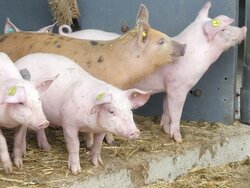Dossier
Sustainability standards and certification systems
Christian von Dorrien, Josef Efken | 03.06.2022
Product packaging is colourful: there is a multitude of sustainability labels. For consumers, this landscape of seals is primarily confusing. What lies behind the seals of approval and the associated certification systems.
The objectives of sustainability standards are diverse. Many primarily pursue ecological goals (Marine Stewardship Council, Forest Stewardship Council, Bioland). Other standards focus on social aspects (Fairtrade), animal welfare (Initiative Tierwohl), product quality and safety (GlobalGAP) or climate protection (Carbon Trust). While some standards address consumers directly via a seal (business-to-consumer), others are not communicated to consumers but serve to safeguard certain requirements along the value chain (business-to-business).
The Thünen Institute investigates the design and impact of standards and certifications as well as consumer attitudes and in some cases is actively involved in the development of standards.
Standards that go hand in hand with a certification system are usually voluntary and have been developed predominantly by private actors. They are, for example, the result of a multi-stakeholder process (Round Table on Sustainable Palm Oil), were initiated by food retailers (GlobalGAP) or are the initiative of NGOs (Fairtrade). The best-known governmental voluntary standard is the EU Organic Standard.
Some voluntary standards have such a dominant market position that they have become quasi-mandatory, as producers can hardly market their products without a corresponding certification. This applies, for example, to the QS standard for meat products in Germany.
Trustworthy certification systems require certification by an independent and accredited certification body. As a rule, all criteria must be met for certification. However, some certification schemes differentiate between voluntary and mandatory criteria or operate according to a points system where producers can choose from a catalogue of criteria to achieve a certain number of points.
Especially for animal welfare standards, there are often several recognition levels, of which the lowest level is relatively easy to achieve, while the highest recognition level corresponds to the husbandry conditions in organic farming. The different levels of recognition are also reflected in the labelling, for example by different numbers of stars on the label.
Ideally, traceability of certified products is ensured along the entire value chain. This is why many certification systems require a "chain of custody" certification, where not only the producers of the raw goods, but also all traders, processors and other actors along the value chain have to be certified.
However, a strict separation between certified and non-certified goods is not always mandatory: Mixing certified and non-certified goods can be permissible if the quantity ratios remain traceable within the framework of a mass balance. An example of this is the "FSC Mix" label for products that are made of at least 70 percent certified raw material.
For some standards, for example the Round Table on Sustainable Palm Oil (RSPO), a so-called book-and-claim certification is also permitted. Here, producers can sell the certificates for their sustainably produced palm fruit independently of the physical goods. The buyers of these certificates are then allowed to declare their palm oil, which does not have to be sustainably produced, as "sustainable". The sellers of the certificates, on the other hand, must consequently sell their goods as non-certified goods.
Sustainability certification in the agricultural, fisheries and forestry sectors has gained enormous importance in recent years. Nevertheless, the question arises as to whether sustainability certifications are actually successful in terms of their objectives. In order to assess the success of a certification system, it makes sense to look at different dimensions of success. In this context, we have identified four relevant dimensions of success.
There are a number of factors that affect the success of a certification system. These success factors relate to the standard objectives, the standard criteria, the certification process and the governance of the certification system. Sustainability certifications are also partly used to fulfil legal guidelines. However, certification systems cannot replace state control of the corresponding guidelines.
- Problem-solving capacity: A standard usually pursues the goal of contributing to the solution of a specific problem. However, this only works if the standard criteria actually aim to solve the problem and if the standard goals can be achieved at all with the help of certification.
- Effective behaviour change: Whether a standard contributes to solving a problem also depends on WHO gets certified. It is conceivable that mainly producers who already comply with the standard criteria to a large extent will be certified according to a certain standard. In this case, certification does not contribute to a change in behaviour on the part of producers, but merely remunerates existing behaviour.
- Market penetration: In the end, the best standard will not be able to make a significant contribution to solving the problem if it is not also demanded by consumers and implemented by a significant number of producers. Here it is necessary to find the golden mean between high standard requirements and their implementability at a reasonable cost.
- Awareness raising: The success of a certification scheme can also be expressed by raising awareness of certain issues among companies, policy makers as well as the general public. This can be achieved, for example, through effective public relations work.
- Standard targets: On the one hand, the standard targets should be designed in such a way that a certification system can actually contribute to their achievement. Secondly, there should be a demand and a willingness to pay for these targets on the part of consumers or on the part of certain buyers within the value chain.
- Standard criteria: The standard criteria must strike a balance between potential impact and feasibility: Very strict criteria lead to expensive and time-consuming implementation, which is why only few producers will decide to implement the standards. If, on the other hand, the criteria are not ambitious enough, implementation of the standard will only contribute to solving the problem to a very limited extent.
- Certification process: As a rule, certification is expected to be carried out by an independent and accredited certification organisation (third-party certifi-cation). Ideally, the financial dependence of the certification organisation on the companies to be certified should not be too great. In addition, there should be mechanisms that - beyond accreditation - provide for control of the certification organisation and, in the case of misconduct, also sanction measures. The quality of the audits must be ensured, for example through regular further training of the auditors and clearly defined processes.
- Governance: The term governance covers the management and organisation of a certification system. Good governance involves all relevant stakeholders in standard development and other decision-making processes. Given the increasing complexity of standards, advisory services can help to make certification possible for all interested producers. Other important factors are a good marketing strategy and effective political and social lobbying for the standard's objectives. Ideally, the effectiveness of the certification system should be regularly reviewed and improved. In addition, all relevant information should be publicly available and transparent. In order to prevent fraud and ensure trust in the certification system, an effective traceability system and control should also be established.





![[Translate to English:] Episode 8: One label fits all?](/media/_processed_/7/8/csm_Foto_Folge8_79a08d0da3.png)





